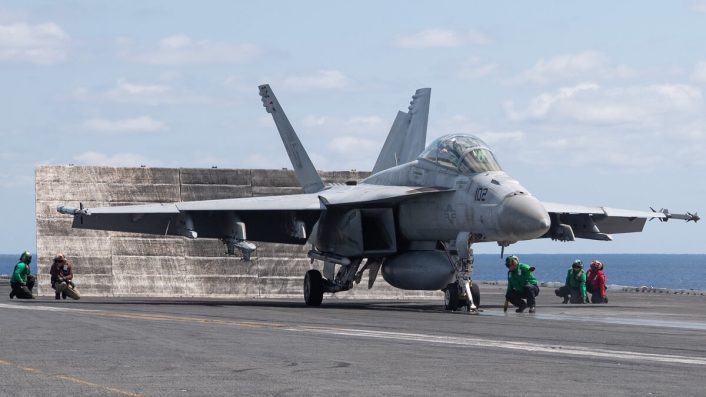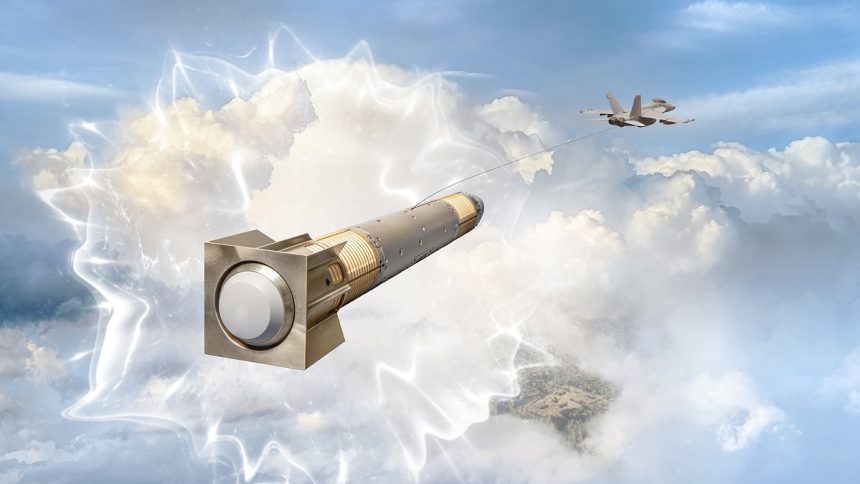The new radio frequency countermeasures build on the capabilities of the AN/ALE-55 Fiber-Optic Towed Decoy and will be fully integrated with the onboard self-protection system of the F/A-18E/F Super Hornet.
The U.S. Navy has selected BAE Systems to develop the new Dual Band Decoy (DBD) to equip the F/A-18E/F Super Hornet fleet. The new cutting-edge radio frequency (RF) countermeasure will lure radar-guided missiles away from the aircraft, shielding it from enemy attacks.
The contract was actually awarded in Sept. 2023, however it was only announced by the company last week. The contract, worth more than 54 million USD, covers design, development, integration, testing, production, and delivery of the Dual Band Decoy and was awarded to BAE Systems after a competition with Raytheon.
In fact, the first contract to develop and demonstrate a new decoy was awarded to both BAE Systems and Raytheon in 2019, with Raytheon later disqualified. After the Government Accountability Office rejected Raytheon’s protest, the new contract was awarded to BAE Systems.
The company says the Dual Band Decoy is part of its Intrepid Shield approach to creating a protective sphere around platforms in highly contested battlespaces using the full electromagnetic spectrum to detect, exploit, and counter advanced threats. This approach leverages the radio frequency (RF) and electro-optical/infrared (EO/IR) parts of the spectrum to increase survivability and lethality for aircraft in high-threat scenarios.
The Dual Band Decoy
The Dual Band Decoy will expand the capabilities of BAE Systems’ combat-proven AN/ALE-55 Fiber-Optic Towed Decoy, currently equipped by the Super Hornet fleet. The decoy delivers the latest jamming technology to disrupt enemy radars and lure missiles away from the aircraft, says the company.
“With Dual Band Decoy, we are building on the ALE-55’s years of mission success as a high-powered jamming system,” said Don Davidson, director of the Advanced Compact Electronic Warfare Solutions product line at BAE Systems. “Dual Band Decoy delivers broad capability that can be installed on a variety of aircraft and is upgradeable to address future threats.”

The system consists of a towed unit connected by fiber-optic cable to electronic warfare equipment onboard the aircraft. The decoy can either be manually launched by the pilot or automatically in response to threats, improving the protection in highly contested airspace.
The functioning will be similar to the ALE-55’s, which jams signals with a high-powered response from off-board the aircraft at the end of the towline. The decoy works in concert with the aircraft’s onboard electronic warfare system to use a variety of countermeasure techniques to suppress, deflect, and seduce pulsed and continuous wave (CW) RF threats.
The ALE-55 Fiber-Optic Towed Decoy
The ALE-55 fiber-optic towed decoy is a highly advanced RF self-protection jammer that is already operational with the U.S. Navy F/A-18E/F Super Hornet and EA-18G Growler fleets and has been proven to be highly-effective against RF missile threats. The decoy is fully integrated with the ALQ-214 Integrated Defensive Electronic Countermeasures (IDECM) installed on the aircraft.
The ALE-55 towed decoy, as the name says, is a compact jammer towed by a fiber-optic cable which works together with the aircraft’s onboard Electronic Warfare (EW) system, jamming signals from incoming missiles with a high-powered response and guiding them safely away from the aircraft to the towed decoy. After the decoy is hit by the missile, the aircraft can then cut the towing cable and deploy another decoy if needed.
The ALE-55 was first fielded in 2010, employed as alternative to the ALE-50 “Little Buddy” Towed Decoy System used by older block configurations of IDECMS. Since then, BAE Systems has produced more than 3,000 ALE-55 decoys for customers around the world.









